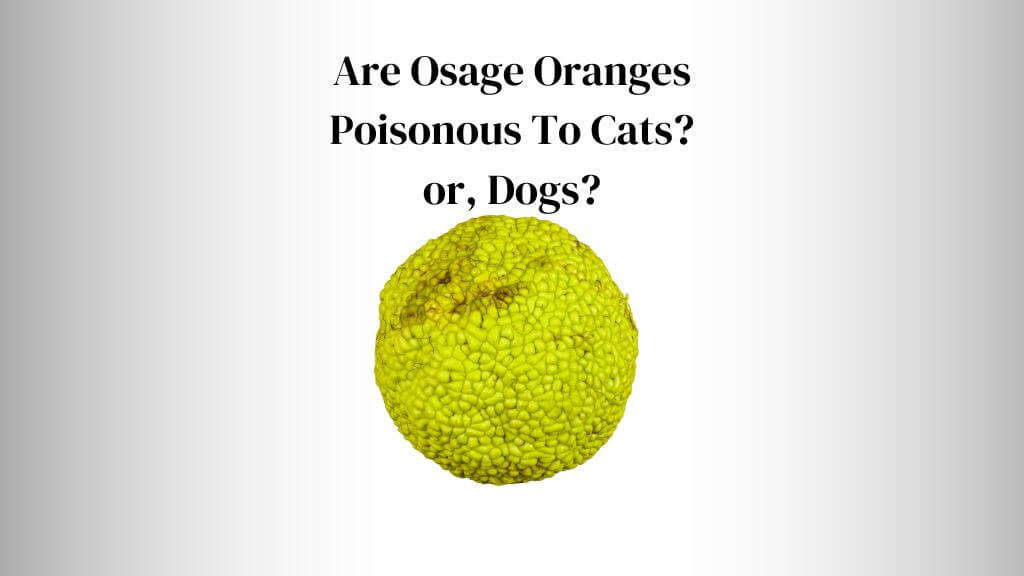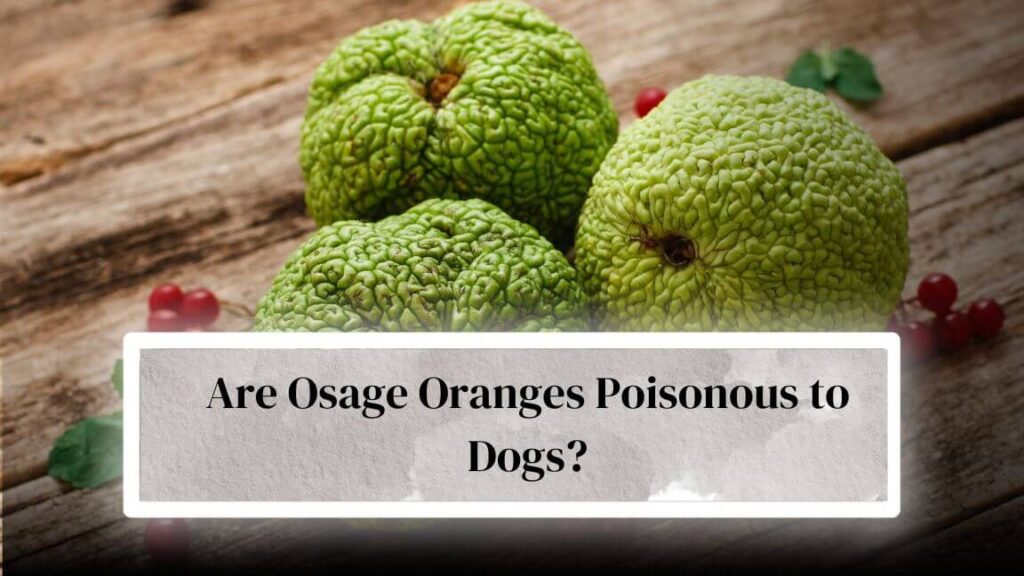
Osage oranges, also known as hedge apples, are in many parts of the United States & rest of the world. If you want to know whether a dog or cat can eat these large, green, and bumpy fruits, then you’re in the right article. Today I’ll answer a few frequently asked questions on the topic ‘Are osage oranges poisonous’ and if not, ‘Are osage oranges poisonous to cats’ or ‘Are osage oranges poisonous to dogs’?
There is no doubt that osage oranges are commonly used as a natural insect repellent, and you’ll notice this specimen in many homes, gardens, & barns.
Well, there is some debate over whether they are safe for pets to consume, which I’ll clarify in this post. But before I tell you these things, you should know the type of chemical compounds in the osage orange that might be toxic to other animals or us.
Chemical Compounds Found in Osage Oranges

If you know what chemical compounds are present in osage oranges, you will be able to understand what contributes to toxicity in large quantities. Osage oranges contain several chemical compounds, including:
- Beta-carotene
- Fatty acids
- Tannins
- Flavonoids
- Alkaloids
- Phenolic acids
Are Osage Oranges Poisonous?
Even though the toxicity of osage oranges is much debated, its fruit is not poisonous to humans; it is generally considered inedible due to its unpleasant taste & texture, but still, eat it in small amounts. Avoid offering this fruit to livestock like horses, cattle, or sheep, as it can have toxic effects.
Suppose your livestock, like horses, cattle, or sheep, ingests high amounts of osage orange fruit or osage orange leaves. In that case, it can potentially lead to digestive upset, neurological symptoms, and even death in some cases.
You should know that the chemical composition of osage oranges plays a significant role in their toxicity. Animals and humans may experience gastrointestinal upset due to high levels of tannins & alkaloids found in the fruit.
Eating this fruit daily or in large quantities can also be very damaging to the liver & kidneys. Adding to this, theosis or fruits are said to be high in fatty acids, making them very difficult to digest, leading to high chances of digestive upset and diarrhea.
The Osage Orange and several similar fruit trees are part of the Moraceae family and share similar chemical properties to the Osage orange tree. Some of them include
- Maclura pomifera (Osage orange)
- Maclura tinctoria (Fustic)
- Maclura tricuspidata (Bodhi tree)
- Related Articles
- How To Eat An Osage Orange?
- Can Osage Orange Fruit Be Eaten
- How To Eat An Osage Orange?
Osage Oranges & Humans
Since osage oranges are not considered poisonous to humans, you can eat them in considerable amounts. Avoid eating too many, as it can cause gastrointestinal upset & allergic reactions in some people.
If you notice any osage orange poisoning symptoms, you must talk to your doctor immediately. Some of the symptoms of poisoning in humans:
- Nausea
- Vomiting
- Diarrhea
- Stomach pain
- Headache
- Dizziness
- Allergic reactions
If you notice any of the symptoms mentioned above, you should consider managing them using over-the-counter medications and ensuring adequate hydration.
If you think the symptom is severe or persistent, you must seek medical attention immediately. It would help to take proper precautions to avoid allergic reactions and irritation when handling overseas oranges.
To do that, consider wearing clothes and long sleeves while avoiding touching your face or eyes until you thoroughly wash your hands.
Are Osage Oranges Poisonous to Dogs?

In general, Osage oranges are not considered toxic to dogs, but that doesn’t mean they are safe to eat. The fruit’s tough, fibrous texture is found to be difficult for dogs to digest. Thus, offering too many may cause gastrointestinal upset or blockages in some cases.
Additionally, you must avoid feeding seeds inside the fruit to your dog as it contains a small amount of a toxic compound called strychnine. Although the strychnine amount is generally considered too small to cause any harm, your dog is still at risk of poisoning if they ingest too much.
If you’re wondering whether to feed Osage orange fruits to your dog or not, it’s better not because it is not recommended. However, If your dog does happen to eat some of the fruit, you must monitor your pet closely for any signs of digestive upset or other symptoms. Here are some potential risks of feeding osage oranges to dogs include:
- Gastrointestinal upset: as I told you earlier, osage orange fruit contains a tough, fibrous texture, which can be difficult for your dogs to digest. Giving too much can lead to vomiting, diarrhea, or constipation.
- Blockages: also, a few people have reported their dog suffering from blockage due to ingesting too much fruit. Please pay attention to this because a lodged object in their intestine may require surgery to be removed.
- Toxicity: As I told you previously, the seeds of osage oranges contain small amounts of strychnine, which can harm your dog if ingested too much.
Unfortunately, If your dog does ingest a large number of osage oranges or their seeds, here are a few symptoms of poisoning that they may experience:
- Restlessness
- Agitation
- Seizures
- Difficulty breathing
- Muscle stiffness
- Convulsions
Note: If your dog exhibits any of these symptoms, you must seek veterinary attention immediately.
Are Osage Oranges Poisonous to Cats?
Like dogs, osage oranges are not considered toxic to cats but can still pose a potential risk. You don’t need to worry much because few lines are less likely to feed on this type of fruit than dogs.
But if your cat does, she might experience similar digestive upset or blockages, so seek vet assistance. Even though cats can technically eat osage oranges, it is never recommended. Feeding osage Orange to feline poses potential risks, including blockages and gastrointestinal upset.
If your cat ingests too much of this fruit, it may become lodged in its digestive system, which could further cause blockage, requiring surgery to remove it in some cases.
If you think your feline has accidentally ingested a large quantity of Osage Orange, she is likely to exhibit symptoms of blockages or digestive upset. However, if your cat ingests the seeds, she may experience symptoms of strychnine poisoning like
- Agitation
- Seizures
- Difficulty breathing
- Muscle stiffness
- Convulsions
Note: if you notice your cat becoming restless or exhibiting any of the above symptoms, contact your veterinarian as soon as possible.
Prevention of Poisoning
One of the best ways to prevent osage orange poisoning in pets is by keeping the fruit out of their reach. On the other hand, If you have osage orange trees on your property, you should always pick up the fallen fruit and dispose of it properly.
In addition, when you’re out walking your dog or taking your cat for a stroll, please keep your pets away from areas where they may come across osage oranges. It would help if you also considered teaching your pets to avoid picking any food from the grounds unless it is offered directly by hand.
However, suppose you want to plant an Osage Orange tree in your garden or landscape but are worried about your pet. In that case, you can take a few precautions, like making that particular area inaccessible to your pets or planting a barrier around your tree to keep it protected from your pet.
What To Do If Poisoning Occurs
Suppose you notice your cat or dog exhibiting any poisoning symptoms or suspect that your beloved pet has ingested a considerable amount of osage oranges. In that case, you need to get it checked immediately at the nearest veterinary care.
You should know that time is of the essence when it comes to treating poisoning. So, it would help if you never hesitated to call your veterinarian for professional assistance and promptly take your pet to the nearest veterinary clinic or animal hospital.
Professional veterinarians recommend inducing vomiting to remove fruit from your dog /cat system by administering fluids & medications.
In severe cases of osage orange poisoning, your veterinarian may perform emergency treatment like surgery to remove blockages from the digestive tract or provide supportive care like intravenous fluids & medications to manage symptoms.
Depending upon the severity of osage orange poisoning, your veterinarian will choose the right approach.
Conclusion
Even though Osage Orange fruits are not poisonous to dogs & cats, they can still cause considerable damage. It is still harmful to their health if consumed in large quantities. Livestock like horses, cattle, and sheep should never consume osage orange fruit.
Although humans can safely eat and enjoy this fruit, it’s also better to avoid it. If you still want to eat it, prepare it first. After reading this, you have no concerns regarding this fruit’s edibility to dogs and cats. If you find this article helpful, then consider sharing it.
Your share will help many people keep their pets away from this tree & its fruits. Even the leaves of Osage oranges can be toxic to dogs or cats if eaten in large amounts. Do check our other helpful guide on care and management. See you in the next post. Till then, take care & goodbye.
